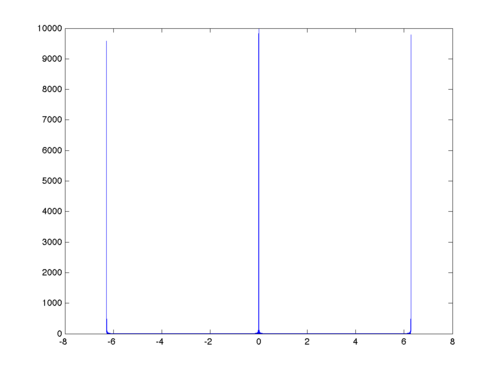| Line 1: | Line 1: | ||
| + | [[Category:discrete-time Fourier transform]] | ||
| + | [[Category:ECE438Fall2010Boutin]] | ||
| + | |||
| + | |||
=Discrete-time Fourier transform of a window function= | =Discrete-time Fourier transform of a window function= | ||
Used in [[ECE438]]. | Used in [[ECE438]]. | ||
Latest revision as of 08:25, 29 December 2010
Discrete-time Fourier transform of a window function
Used in ECE438.
This page can be used to study the frequency-domain behavior of a discrete-time window function, as its length increases.
Consider the perfect discrete-time window function
$ w[n]= \left\{ \begin{array}{ll} 1,&\text{ if }0 \leq n < N \\ 0, & \text{ else}. \end{array} \right., $
for any integer values of n. Note that N represents the length of the window. The DTFT of this window function is
$ W(\omega) =\frac{e^{\frac{-j \omega (N-1)}{2}} \sin\left( \frac{\omega N}{2}\right)}{\sin \left( \frac{\omega}{2} \right)} $.
Below is the graph of the magniture of $ W(\omega) $ for $ N=15 $.
Below is the graph of the magniture of $ W(\omega) $ for $ N=100 $. Observe that the ripples are "thinner" and more numerous than in the previous case of $ N=10 $.
Below is the graph of the magniture of $ W(\omega) $ for $ N=10000 $.
Observe the close resemblance of this graph to that of the magnitude of the Fourier transform of the signal $ x[n]=1 $, for any n integer (in other words, an "infinite-length" window).




